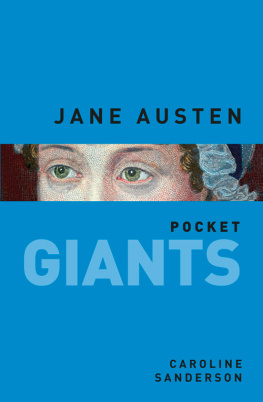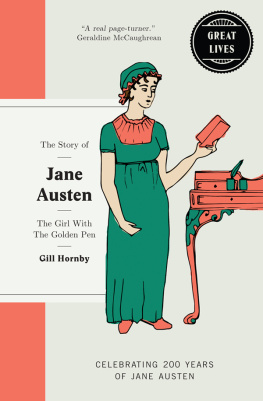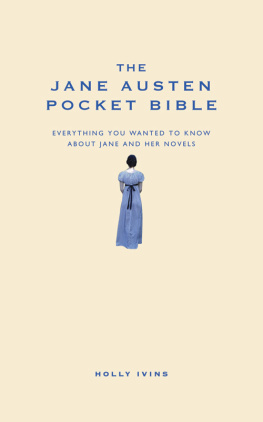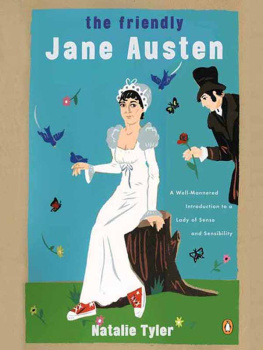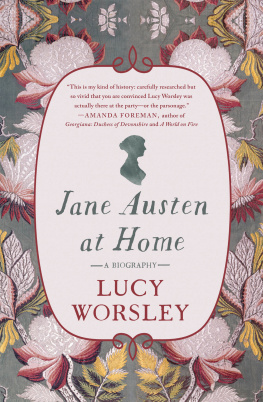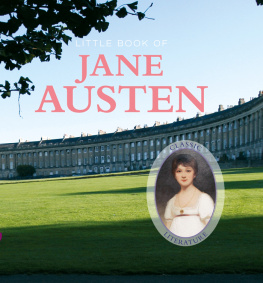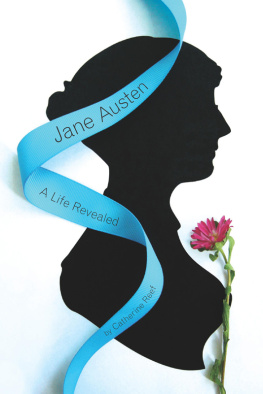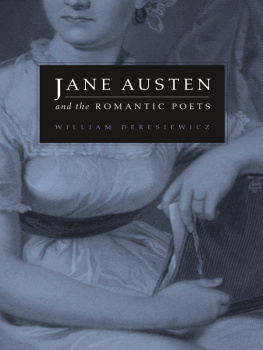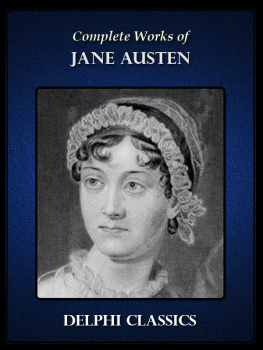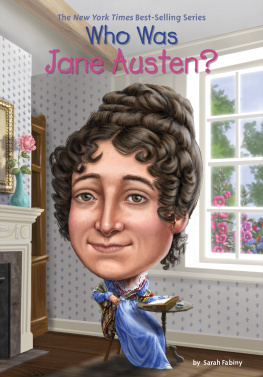
Thank you to: my mother Margaret, whose school prize copy of Pride and Prejudice was the start of it. And my discerning daughter Julia who is Jane Austens latest fan.
Contents
Introduction
These boo-words, insular, parochial and domestic could be used against Jane Austen and have been used on occasion. But she was a great writer. It is easy to mistake what is exotic and unfamiliar for real originality.
David Lodge, 1999
Jane Austen died aged only 41, didnt marry, never had children and lived out her days in the south of England, rarely straying from the genteel and orthodox social circle into which she was born. She completed only six full-length novels, and tasted only brief and limited fame in her lifetime.
Yet, 200 years after her death, she is one of the worlds most revered writers, a literary giant, her life the topic of dozens of biographies, her work the subject of thousands of academic studies. In recent decades, her novels have frequently been adapted for television and film. The internet has spawned countless blogs and websites on which all things Austen are analysed and adored. There are mugs, and tea towels, and t-shirts, and books of Jane Austen quotations, and instructions on just how manners maketh man and woman according to her expert word.
Novels have been written in imitation of her own, in tribute to her own and in completion of her own. There are sequels, parodies and eroticised versions of her writings, and, most entertainingly perhaps, contemporary mash-ups, including recent bestseller Pride and Prejudice and Zombies , which bears the subtitle, The Classic Regency Romance now with Ultraviolent Zombie Mayhem! Jane, who was not at all averse to a good parody, and wrote several of her own, would probably have found all this adoring preoccupation with her work highly amusing. As she once wrote:
I could not sit seriously down to write a serious romance under any other motive than to save my life, and if it were indispensable for me to keep it up and never relax into laughing at myself or other people, I am sure I should be hung before I had finished the first chapter.
In this hyper-connected world, why do we still care so much for her stories, drawn in the far-off days of the late eighteenth and early nineteenth centuries on to such a small canvas, the little bit (two inches wide) of ivory on which I work with so fine a brush, as Jane Austen herself once called it. You are now collecting our People delightfully, getting them exactly into such a spot as is the delight of my life; 3 or 4 Families in a Country Village is the very thing to work on, she advised her aspiring novelist niece Anna, in 1814. Her own novels rarely extend beyond these parameters, and the biggest dramas we encounter are broken engagements, sprained ancles and that now quaint social crime: elopement.
Despite the fact that she lived in turbulent times, there are no wars in Jane Austen. Poverty and rural crime, which was all too present even in her limited world, rate scarcely a mention. Her plots can be summarised as: girl meets boy and eventually, after varying obstacles are overcome, they marry.
And yet theres still something about Jane, far beyond the famous romances which are the subject of her novels. Over 200 years after they were written they still capture the complexities of human beings, and the nuances of their relationships, with all their joys, tensions, contradictions and ironies and they continue to beguile readers the world over.
This spinster novelist with little experience of the wider world, raised on a diet of swooning, unrealistic tales of love and scandal, was a genius at observing and describing ordinary human behaviour. Her narratives are immensely satisfying because of the sophistication of their construction and the precise brilliance of the style with which they are told. Her dialogue never sounds less than true.
Sir Walter Scott, the most popular novelist of his day, was one of the first to recognise Austens talent in this respect, declaring himself envious of her exquisite touch which renders ordinary common-place things and characters interesting from the truth of the description and the sentiment. Genteel ladies and gentlemen, whose behaviour rarely deviates from acceptable social norms, her characters may be, but as she declares in Emma , what Jane Austen understood so well was that seldom, very seldom does complete truth belong to any human discourse.
Scratch the surface of her characters polite social exchanges and universal, timeless human dilemmas emerge. Is this man all he seems to be? Is my friend true? Am I really in love? Hypochondriacs are annoying. Some girls are very silly. Some men are only out for what they can get. Some women only care about money. Austens insights into what goes on in the human head and heart beneath the social veneer are second to none. The smallest telling detail a word, a turn of phrase, a witty aside, a foolish remark, a look, a look away can reveal the innermost workings of her characters hearts and minds.
Virginia Woolf once remarked that of all great writers, Jane Austen was the most difficult to catch in the act of greatness. It is her minute attention to detail that makes Austen such a giant of a writer and such a favourite of so many readers. Her novels can be returned to again and again, throughout life, because on each reading they will reveal something new. Read her as a teenager and, despite Janes own protestations that she couldnt write a serious romance to save her life, her novels present themselves as love stories, where the heroine always gets the right man in the end, but finds out things she needs to know about him and about herself along the way. Read them when older, and perhaps more cynical about life and relationships, and her characters reveal not so much their romantic aspirations but the extent to which property, status, health and wealth preoccupy them.
In short, Jane Austens stories give her readers a profound sense of her characters inner lives. So what does her own life story tell us?
Notes
Quoted in The Guardian , 11 May 1999.
Le Faye, Deirdre (ed.), Janes Austens Letters (Oxford University Press, 1997), p. 312.
Ibid., p. 275.
The Journal of Sir Walter Scott , March 1826 (Cambridge University Press, 2013).
Quoted in Southam, Brian, Jane Austen: The Critical Heritage (Routledge, 1968).
1
Her fire began with herself.
G.K. Chesterton
Jane Austens story starts in Steventon, a small and little-known village buried deep in the Hampshire countryside. Even today, in this heritage industry era when the birthplaces of famous writers come with coach parks and souvenir shops, not even the smallest monument commemorates Jane Austens birth in the green field which marks its location.
The Reverend George Austen and his wife Cassandra had moved to Steventon in 1771 from the parsonage in the nearby village of Deane. Seven years after their marriage in Bath in 1764, they had a growing family of three sons: James, George and Edward. Years later, in his A Memoir of Jane Austen , Janes nephew James Edward Austen-Leigh imagined the scene on the day of the move to Steventon: Mrs Austen, who was not then in strong health, performed the short journey on a feather-bed, placed upon some soft articles of furniture in the waggon which held their household goods, for the road was a mere cart track, so cut up by deep ruts as to be impassable for a light carriage.
Next page
